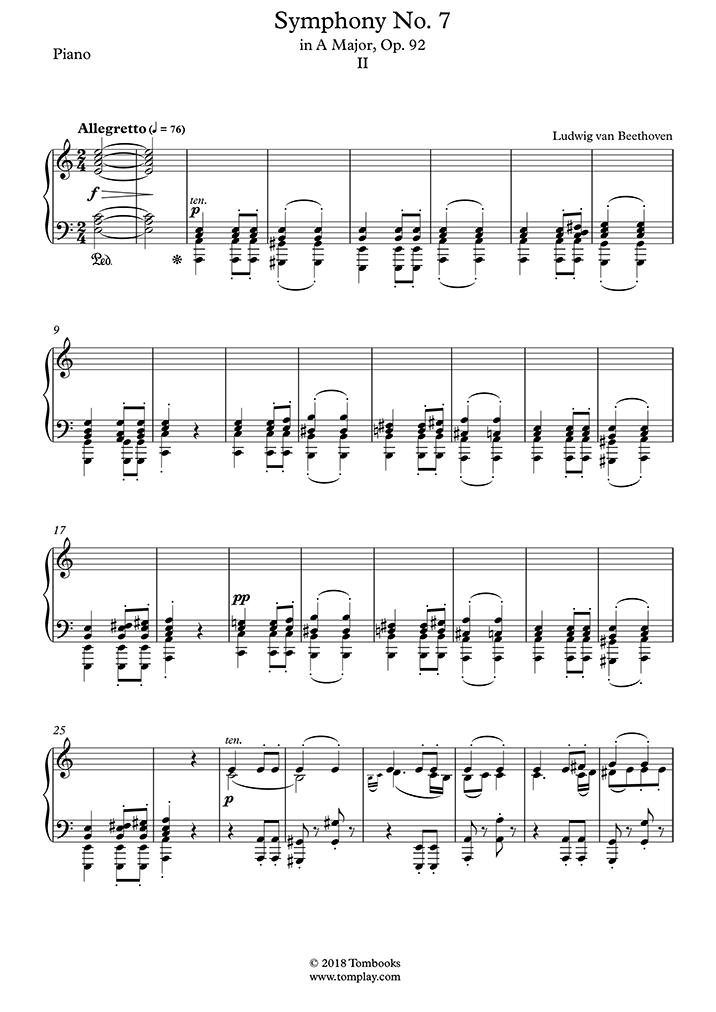
Beethoven 7Th Symphony Slow Movement Full Answer Besides
After a bright.Click to see full answer Besides, what is the rhythm of Beethovens 5th Symphony Folia is a dance form with a distinctive rhythm and harmony, which was used by many composers from the Renaissance well into the 19th and even 20th centuries, often in the context of a theme and variations. They also share a connection with Johann Nepomuk Maelzel (1772-1838), who was part musician and part engineer, but mostly an entrepreneurial salesman.The ballet opens with a lighthearted, yet noble first movement, followed by a slow and sensuous pas de deux filled with yearning and passion. The second movement, Allegretto, was instantly popular and was frequently performed separately from the complete symphony.Beethoven’s Seventh and Eighth are a set of “untwins,” contrasting works created basically side-by-side in 1811-1812. The piece premiered in Vienna in 1813, with Beethoven himself conducting - with great vigour At its premiere, Beethoven was said to have commented that it was one of his best works.
Maelzel also created the Panharmonicon, a mechanical chamber orchestra. Marked a little lively though it is considered the slow movement due to its.Maelzel was named “court mechanician” in Vienna in 1808, and one of his principal product lines was ear trumpets, which Beethoven eagerly – desperately – tried. 3 hours ago The 2nd movement of Beethovens 7th symphony, performed by the.
Rodrigo - Concierto de Aranjuez: This achingly beautiful slow movement can't go unnoticed.The second movement of Beethovens 7th Symphony, the Allegretto, has been captivating listeners since its creation in 1813. I think it's the best slow movement written by Mahler, something that is beyond me. Mahler - Symphony 6: This is a very strong candidate.

It had to be encored at the premiere and was so popular in the 19th century that it often was substituted into other Beethoven symphonies.The Scherzo is a blazingly fast one, with a much slower Trio section. The introduction predicts the harmonic journeys coming in the rest of the Symphony just as the main body of the movement foretells its rhythmic obsessions, and the startling coda walks the wild side.The following Allegretto – the work has no really slow movement – has a solemnly welling beauty intensified by counterpoint. Beethoven conducted and all of the music was much admired, though to the composer’s irritation the Seventh Symphony was referred to as a “companion piece” to Wellington’s Victory.The Symphony begins with a long and profound introduction, before kicking into kinetically energized music, which characterizes the entire work and has generated the many allusions to dance that dominate commentaries on it. Domenico Dragonetti led the basses, and composers and pianists Giacomo Meyerbeer, Johann Nepomuk Hummel, and Ignaz Moscheles all played percussion in the battle piece, for which composer Antonio Salieri served as a sort of assistant conductor. Beethoven’ favored quartet leader, Ignaz Schuppanzigh, was the concertmaster and next to him sat the violinist/composer Louis Spohr. The occasion and Beethoven’s celebrity were such that the orchestra was almost an all-star band.


 0 kommentar(er)
0 kommentar(er)
